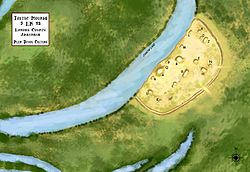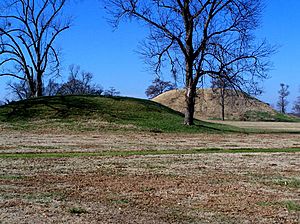Plum Bayou Mounds Archeological State Park facts for kids

Artist's conception of the archaeological site
|
|
| Alternative name | Toltec Mounds |
|---|---|
| Location | Lonoke County, Arkansas, US |
| Region | Central Arkansas |
| Coordinates | 34°38′49″N 92°3′55″W / 34.64694°N 92.06528°W |
| Type | Settlement |
| History | |
| Founded | 7th century |
| Abandoned | 11th century |
| Cultures | Plum Bayou culture |
| Site notes | |
| Ownership | Government of Arkansas |
| Management | Arkansas State Parks |
| Public access | Yes |
| Architecture | |
| Architectural styles | platform mounds, burial mounds, plazas |
| Architectural details | Number of monuments: |
|
Plum Bayou Mounds Site
|
|
| NRHP reference No. | 73000382 |
| Significant dates | |
| Added to NRHP | January 12, 1973 |
| Designated NHL | June 2, 1978 |
| Responsible body: State | |
The Plum Bayou Mounds Archeological State Park is an amazing ancient site in Arkansas. It was once known as "Toltec Mounds Archeological State Park." This special place protects 18 large mounds built long ago. These are the tallest surviving prehistoric mounds in Arkansas.
The site sits next to Mound Lake, which is an oxbow lake of the Arkansas River. People lived here from the 7th to the 11th century. Today, it is recognized as a National Historic Landmark.
Contents
What's in a Name? The Story of Plum Bayou Mounds
For a long time, this site was called "Toltec Mounds." People in the 1800s mistakenly thought the Toltec people from Mexico built these mounds. They believed the Toltec lived in North America.
A woman named Mary Knapp owned the land for many years. She was very interested in archaeology. Mary wrote letters to the Smithsonian Institution about the "Toltec Mounds." She even sent them artifacts she found.
This led to an investigation in 1883 by archaeologist Edward Palmer. His work, and that of others, proved something important. It showed that the mounds were built by the ancestors of Native Americans who lived in this region. These people were part of many "mound building cultures" across the United States. They built earth mounds for religious, political, and ceremonial reasons. These mounds were connected to their beliefs about the world.
The name Plum Bayou comes from a nearby waterway. It was chosen to describe the unique culture of the people who lived here. In November 2022, the site was officially renamed Plum Bayou Mounds. This change happened after talking with the Quapaw Nation and the Arkansas Archaeological Survey.
Who Were the Plum Bayou People?
The people who built the Plum Bayou Mounds had a special culture. It was different from other Native American groups living in the Mississippi Valley at that time. You can find Plum Bayou sites in central and eastern Arkansas, near the White River and Arkansas River floodplains. Some sites are even found in the eastern Ozark Mountains.
Plum Bayou Mounds is the largest and most important site of this culture. Scientists are still learning about how these people connected with nearby cultures. These included the Coles Creek culture to the south and Fourche Maline culture to the southwest. The Plum Bayou people lived in permanent villages. They built strong houses, farmed, gathered wild plants, fished, and hunted for food.
Life at Plum Bayou Mounds Site
Large mound groups like Plum Bayou Mounds were important centers. They served as religious and social hubs for people living in the surrounding areas. The Plum Bayou Mounds site itself had a smaller population. It was mainly home to the community's leaders and their families. This center was active from the 7th to the 11th century.
The archaeological site was built next to an oxbow lake, now called Mound Pond. It once had a large earthen wall and ditch on three sides. This wall was about 8 to 10 feet (2.4 to 3 meters) high and over a mile (1.6 kilometers) long. Inside this curving wall, 18 mounds were built. Two of these mounds were originally very tall, reaching 38 and 49 feet (11.6 and 14.9 meters) high.
The mounds were placed around two open areas called plazas. These plazas were used for important political, religious, and social events. People from all around would come to attend these gatherings. We know that at least two mounds were used for feasting. Archaeologists found discarded food remains, showing that deer was a favorite meal.
The placement of the mounds was carefully planned. It seems they used special measurements and lined up with important positions of the sun. Most of the mounds were flat-topped platform mounds. Buildings were constructed on top of these flat platforms. Later, in the 15th century, other Native Americans lived at the site. However, they were not the ones who built the mounds.
The Plum Bayou Mounds site was recognized as a National Historic Landmark in 1978. It was also named an Arkansas State Archeological Landmark in 2025.
See also



